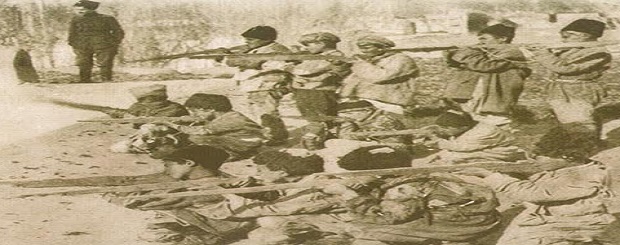
Genocide in photos: Children who joined self-defense of Van
Photograph source: National Geographic, August, 1919
September 5, 2015
The history of the Armenian Genocide was recorded with tens of thousands of documents, including diplomatic reports, witness’ testimonies, memoirs and survivors’ oral stories.
Besides, pictures by Armenian and foreign photographers during the Genocide convey exceptional factual evidence. New photos still keep emerging year after year, proving the fact of the Armenian Genocide and its consequences. The Armenian Genocide Museum Institute gathered photos depicting the Armenian Genocide in a book, titled “100 photo stories on the Armenian Genocide,” and ArmenianGenocide100.org will regularly present them.
The photograph was released in the National Geographic magazine’s second issue of 1919, in an article by Maynard Owen Wiilliams. The little heroes in the photograph, the eldest of whom was twelve years old, overcame many difficulties and reached Van without the permission of Artamet guard. This photograph was undoubtedly taken shortly after the heroic self-defense of Van, but was published in an American journal much later.
“Carrying wooden rifles, they had come to the governor of Van Hambartsumiants [Kosti Hambartsumian (1882-1918) – reference by ArmenianGenocide100.org] to demand real weapons, for they were ready to fight till the end and defend their families, with some of their relatives already gone,” Williams writes.
During the years of the Armenian Genocide self-defense battles were held in several cities of Western Armenia. The fierce resistance that took place in the city of Van from April 7 to May 6, 1915 ended in a victory. The excellently organized heroic resistance of Van was the longest and the most decisive one.
Residents of Van fought courageously. The women, elderly and children all took part in the bloody resistance realizing just how important it was to defend their homes and dignity.
“Armenians serving in the military, who, according to the defense minister, fought bravely not only in Dardanelles but also in the Caucasian front against Russia, were mostly disarmed and used by the army as porters or road reconstruction workers. There has been news from nearly all of the districts that Armenians in forced labor were not the only ones to be killed by their Muslim friends in remote places. Groups of 80, 100 and more people were shot dead by soldiers and military gendarmerie that followed the commands of their officers. We will possibly never find out the real numbers of killed Armenian army recruits, at least not until the end of the war.”
Johannes Lepsius
German missioner, eyewitness of the Armenian Genocide
http://www.horizonweekly.ca/news
